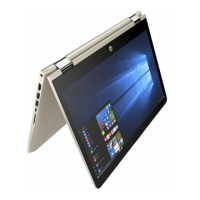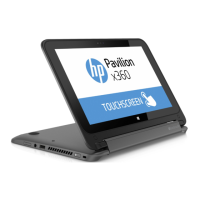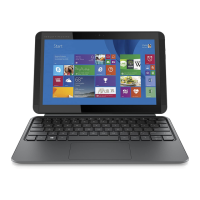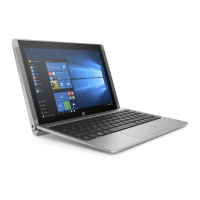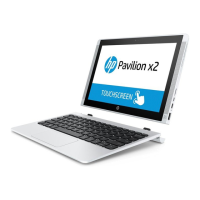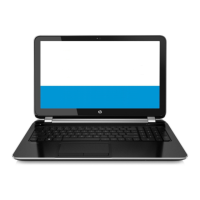Do you have a question about the HP pavilion x360 and is the answer not in the manual?
Understanding and using the computer's power-saving Sleep and Hibernation modes.
Steps to manually start and stop the computer's Hibernation mode.
Procedure for safely shutting down and turning off the computer.
Managing power settings, viewing battery status, and using Power Options.
Information on operating the computer using battery power and conserving its charge.
Tips and methods to conserve battery power and maximize battery life.
Understanding how the computer indicates low or critical battery levels.
Steps to resolve low battery issues under different power availability scenarios.
How the computer operates when connected to external power sources.
Keeping software and drivers up-to-date for optimal performance and security.
Creating and managing passwords for Windows and BIOS to protect computer access.
Configuring user and administrator passwords for the Windows operating system.
Establishing administrator and power-on passwords for the computer's BIOS settings.
Importance and use of internet security software to protect against online threats.
Protecting the computer from viruses and malware using antivirus software.
Understanding and using firewall software to prevent unauthorized network access.
Procedure for installing Windows and third-party software updates for security and performance.
Enabling security features to protect wireless networks from unauthorized access.
Importance of regularly backing up data to prevent loss from hardware or software failures.
Steps to access and enter the computer's BIOS setup utility.
Information on checking for and installing updated BIOS versions from the HP website.
How to find the current BIOS version to determine if an update is needed.
Instructions for downloading and preparing to install a BIOS update from the HP website.
Running diagnostic tests within Windows to identify hardware failures.
Steps to download and install the HP PC Hardware Diagnostics Windows utility.
Downloading the newest version of HP PC Hardware Diagnostics Windows.
Downloading diagnostics using the computer's product name or number.
Procedure for installing the downloaded HP PC Hardware Diagnostics Windows software.
Running hardware diagnostics outside the operating system using UEFI.
Steps to start the HP PC Hardware Diagnostics UEFI tool.
Precautions to prevent damage from static electricity during computer handling.
Understanding and using the computer's power-saving Sleep and Hibernation modes.
Steps to manually start and stop the computer's Hibernation mode.
Procedure for safely shutting down and turning off the computer.
Managing power settings, viewing battery status, and using Power Options.
Information on operating the computer using battery power and conserving its charge.
Tips and methods to conserve battery power and maximize battery life.
Understanding how the computer indicates low or critical battery levels.
Steps to resolve low battery issues under different power availability scenarios.
How the computer operates when connected to external power sources.
Keeping software and drivers up-to-date for optimal performance and security.
Creating and managing passwords for Windows and BIOS to protect computer access.
Configuring user and administrator passwords for the Windows operating system.
Establishing administrator and power-on passwords for the computer's BIOS settings.
Importance and use of internet security software to protect against online threats.
Protecting the computer from viruses and malware using antivirus software.
Understanding and using firewall software to prevent unauthorized network access.
Procedure for installing Windows and third-party software updates for security and performance.
Enabling security features to protect wireless networks from unauthorized access.
Importance of regularly backing up data to prevent loss from hardware or software failures.
Steps to access and enter the computer's BIOS setup utility.
Information on checking for and installing updated BIOS versions from the HP website.
How to find the current BIOS version to determine if an update is needed.
Instructions for downloading and preparing to install a BIOS update from the HP website.
Running diagnostic tests within Windows to identify hardware failures.
Steps to download and install the HP PC Hardware Diagnostics Windows utility.
Downloading the newest version of HP PC Hardware Diagnostics Windows.
Downloading diagnostics using the computer's product name or number.
Procedure for installing the downloaded HP PC Hardware Diagnostics Windows software.
Running hardware diagnostics outside the operating system using UEFI.
Steps to start the HP PC Hardware Diagnostics UEFI tool.
Precautions to prevent damage from static electricity during computer handling.
| Form factor | Convertible (Folder) |
|---|---|
| Product type | Hybrid (2-in-1) |
| Product color | Silver |
| Country of origin | China |
| Electronic compass | Yes |
| Motherboard chipset | Intel SoC |
| Memory slots | 2x SO-DIMM |
| Internal memory | 4 GB |
| Memory clock speed | 1600 MHz |
| Memory form factor | SO-DIMM |
| Internal memory type | DDR3L-SDRAM |
| Maximum internal memory | 16 GB |
| Memory layout (slots x size) | 1 x 4 GB |
| 3D | No |
| HDD size | 2.5 \ |
| HDD speed | 5400 RPM |
| HDD interface | SATA III |
| Storage media | HDD |
| Total storage capacity | 500 GB |
| Compatible memory cards | SD, SDHC, SDXC |
| Number of HDDs installed | 1 |
| Display diagonal | 15.6 \ |
| Touch technology | Multi-touch |
| Display resolution | 1366 x 768 pixels |
| Native aspect ratio | 16:9 |
| On-board graphics card ID | 0x5916 |
| Discrete graphics card model | Not available |
| On-board graphics card model | Intel® HD Graphics 620 |
| On-board graphics card family | Intel® HD Graphics |
| Maximum on-board graphics card memory | 32 GB |
| On-board graphics card OpenGL version | 4.4 |
| On-board graphics card base frequency | 300 MHz |
| On-board graphics card DirectX version | 12.0 |
| On-board graphics card dynamic frequency (max) | 1000 MHz |
| Number of built-in speakers | 2 |
| Wi-Fi standards | Wi-Fi 5 (802.11ac) |
| Bluetooth version | 4.2 |
| Ethernet LAN data rates | 10, 100, 1000 Mbit/s |
| Charging port type | DC-in jack |
| USB 2.0 ports quantity | USB 2.0 ports have a data transmission speed of 480 Mbps, and are backwards compatible with USB 1.1 ports. You can connect all kinds of peripheral devices to them. |
| USB 3.2 Gen 1 (3.1 Gen 1) Type-A ports quantity | 0 |
| Pointing device | Touchpad |
| Operating system architecture | 64-bit |
| Battery capacity | 48 Wh |
| Number of battery cells | 3 |
| AC adapter power | 45 W |
| AC adapter frequency | 50 - 60 Hz |
| AC adapter input voltage | 100 - 240 V |
| Cable lock slot type | Kensington |
| Password protection type | Power on |
| Package depth | 305 mm |
| Package width | 520 mm |
| Package height | 69 mm |
| Package weight | 2950 g |
| Operating altitude | -15.2 - 3048 m |
| Non-operating altitude | -15.2 - 12192 m |
| Storage temperature (T-T) | -20 - 60 °C |
| Operating temperature (T-T) | 5 - 35 °C |
| Storage relative humidity (H-H) | 5 - 95 % |
| Operating relative humidity (H-H) | 10 - 90 % |
| Sustainability certificates | EPEAT Silver, ENERGY STAR |
| Bus type | OPI |
| Stepping | H0 |
| Tjunction | 100 °C |
| Processor cache | 3 MB |
| Processor model | i5-7200U |
| System bus rate | 4 GT/s |
| Processor family | Intel® Core™ i5 |
| Processor socket | BGA 1356 |
| Processor threads | 4 |
| Processor codename | Kaby Lake |
| Configurable TDP-up | 25 W |
| Processor frequency | 2.5 GHz |
| Processor cache type | Smart Cache |
| Configurable TDP-down | 7.5 W |
| Processor lithography | 14 nm |
| Processor manufacturer | Intel |
| PCI Express slots version | 3.0 |
| Processor boost frequency | 3.1 GHz |
| PCI Express configurations | 1x2+2x1, 1x4, 2x2, 4x1 |
| Thermal Design Power (TDP) | 15 W |
| Configurable TDP-up frequency | 2.7 GHz |
| Configurable TDP-down frequency | 0.8 GHz |
| Maximum number of PCI Express lanes | 12 |
| Processor code | SR2ZU |
| Processor ARK ID | 95443 |
| Processor package size | 42 x 24 mm |
| Supported instruction sets | AVX 2.0, SSE4.1, SSE4.2 |
| Intel Identity Protection Technology version | 1.00 |
| Intel Stable Image Platform Program (SIPP) version | 0.00 |
| Depth | 250 mm |
|---|---|
| Width | 382 mm |
| Height | 23.9 mm |
| Weight | 2300 g |


